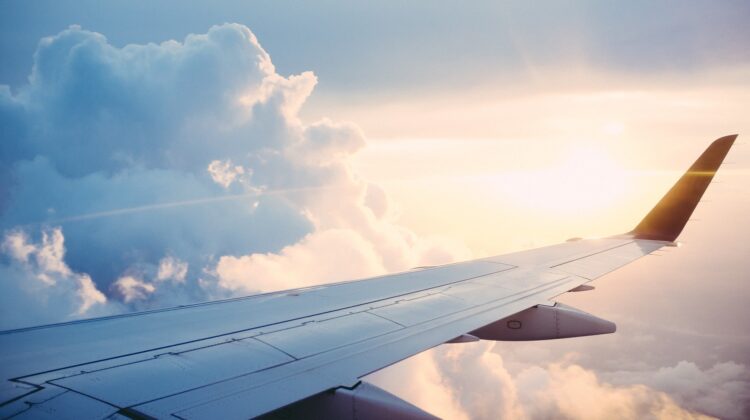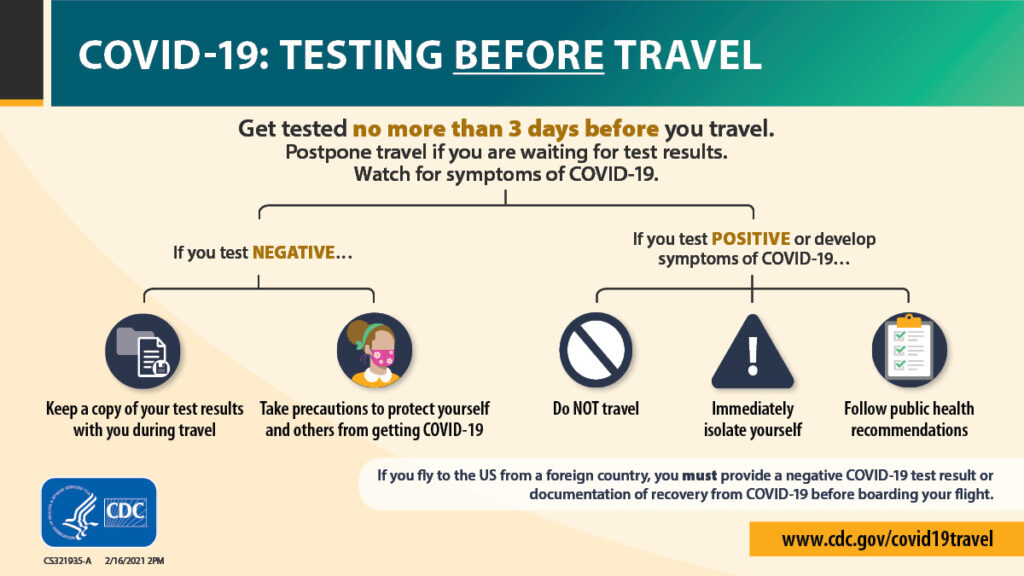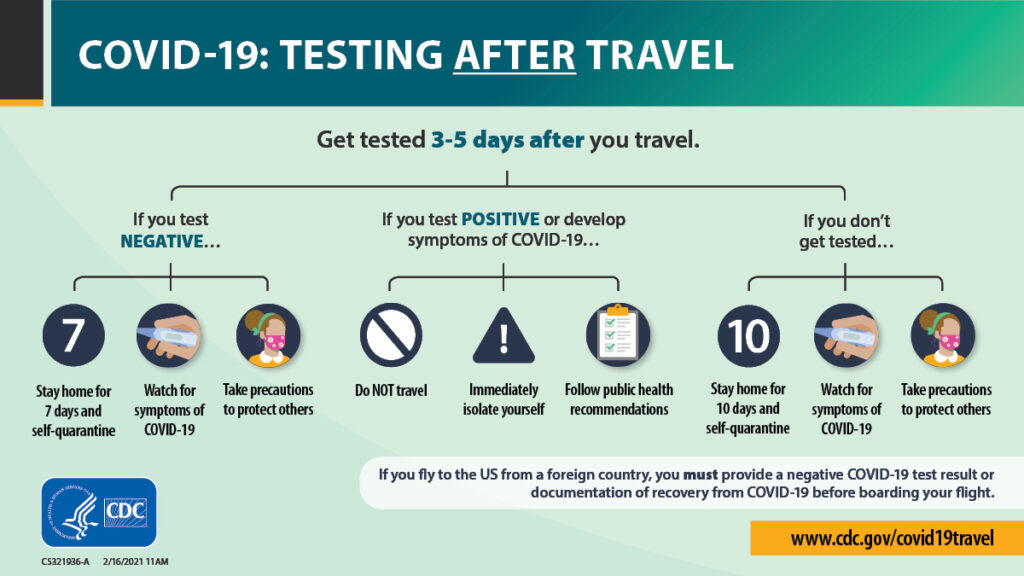
Testing and International Air Travel
New Travel Requirements:
All air passengers coming to the United States, including U.S. citizens, are required to have a negative COVID-19 test result or documentation of recovery from COVID-19 before they board a flight to the United States. See the Frequently Asked Questions for more information.
Masks are required on planes, buses, trains, and other forms of public transportation traveling into, within, or out of the United States and in U.S. transportation hubs such as airports and stations.
Air travel requires spending time in security lines and airport terminals, which can bring you in close contact with other people and frequently touched surfaces. Social distancing is difficult in busy airports and on crowded flights, and sitting within 6 feet of others, sometimes for hours, may increase your risk of getting COVID-19. How you get to and from the airport, such as with public transportation and ridesharing, can also increase your chances of being exposed to the virus.
Testing before and after travel can reduce the risk of spreading COVID-19. Testing does not eliminate all risk, but when paired with a period of staying at home and everyday precautions like wearing masks and social distancing, it can make travel safer by reducing spread on planes, in airports, and at destinations.
Here’s what to know:
Plan ahead: Make sure you understand and follow all airline and destination requirements related to travel, testing, or quarantine, which may differ from U.S. requirements. If you do not follow your destination’s requirements, you may be denied entry and required to return to the United States.
All air passengers coming to the United States, including U.S. citizens, are required to have a negative COVID-19 test result or documentation of recovery from COVID-19 before boarding a flight to the United States.
Make sure that you will be able to get a test at your destination before your return to the United States. Always check and follow state and local recommendations or requirements related to travel in addition to federal requirements.
Get tested with a viral test 1-3 days before you travel. Keep a copy of your test results with you during travel in case you are asked for them. Check and follow destination testing requirements—they may require specific types of tests.
Don’t travel if you test positive; immediately isolate yourself and follow public health recommendations
Delay your travel if you are waiting for test results.
Get tested 3-5 days after travel AND stay home and self-quarantine for 7 days after travel.
Even if you test negative, stay home and self-quarantine for the full 7 days.
If you don’t get tested, it’s safest to stay home for 10 days after travel.
If you are eligible, get fully vaccinated for COVID-19. Wait 2 weeks after getting your second vaccine dose to travel—it takes time for your body to build protection after any vaccination.
Plan Ahead
Check if your airline or destination requires any health information, testing, or other documents. Some destinations require testing before travel and/or after arrival. If you do not follow your destination’s requirements, you may be denied entry and required to return to the United States. You may have to pay any related airline fees. If you test positive at your destination, you might be required to isolate. You might be delayed from returning to the United States as scheduled.
Information about testing requirements for your destination may be available from the Office of Foreign Affairs or Ministry of Health, or the U.S. Department of State, Bureau of Consular Affairs, Country Information webpageexternal icon.
Take steps to reduce higher-risk activities for 14 days before your trip and get tested 1-3 days before you travel. Testing before travel could help reduce the chance that your travel will be interrupted or delayed by COVID-19.
Get Tested Before Your Flight
Below is what you need to know about getting tested before your international flight.
Get tested with a viral test 1-3 days before your trip and again no more than 3 days before your return flight to the United States departs.
Make sure you get your test results before you travel. If you are waiting for results, delay your travel.
Do not travel if your test result is positive; immediately isolate yourself, and follow public health recommendations.
A negative test does not mean that you were not exposed or that you will not develop COVID-19. Make sure to wear a mask, avoid crowds, stay at least 6 feet/2 meters (about 2 arm lengths) from others, wash your hands, and watch your health for signs of illness while traveling.
Keep a copy of your test results with you during travel. You may be asked for them.
Check your destination’s testing requirements before you depart—they may require specific types of tests. If you do not follow your destination’s requirements, you may be denied entry and required to return to the United States.

Get Tested and Stay Home After Travel
Get tested with a viral test 3-5 days after travel AND stay home and self-quarantine for a full 7 days after travel.
Even if you test negative, stay home and self-quarantine for the full 7 days.
If your test is positive, isolate yourself to protect others from getting infected.
If you don’t get tested, stay home and self-quarantine for 10 days after travel.
Avoid being around people who are at increased risk for severe illness for 14 days, whether you get tested or not.
Follow all state and local recommendations or requirements after travel.
Also, take these actions after you return from travel to protect others from getting COVID-19:
Avoid crowds and stay at least 6 feet/2 meters (about 2 arm lengths) from anyone who did not travel with you. It’s important to do this everywhere — both indoors and outdoors.
Wear a mask over your nose and mouth when in public settings. Masks are required on planes, buses, trains, and other forms of public transportation traveling into, within, or out of the United States and in U.S. transportation hubs such as airports and stations.
If there are people in the household who did not travel with you, wear a mask and ask everyone in the household to wear masks in shared spaces inside your home for 14 days after travel.
Wash your hands often or use hand sanitizer with at least 60% alcohol.
Avoid being around people who are at increased risk for severe illness.
Watch your health: Look for symptoms of COVID-19.

Frequently Asked Questions
Where do I get tested?
Visit your state, territorial, tribal and localexternal icon health department’s website to look for the latest information on where to get tested.
When do I need to get a test to travel to the United States and what kind of test do I need?
Get tested no more than 3 days before your flight to the United States departs. Make sure to be tested with a viral test (NAAT or antigen test) to determine if you are currently infected with COVID-19. Also, make sure that you receive your results before your flight departs and have documentation of your results to show the airline.
Do state and local governments in the United States have separate testing requirements for air passengers?
Federal testing requirements must be met to board a plane to the United States. Some state and local governments may have similar or more restrictive testing requirements for air passengers arriving in their jurisdictions. Always check and follow state and local recommendations or requirements related to travel in addition to federal requirements.
Where can I get a test overseas?
For information on where to obtain a test overseas, travelers should review the relevant U.S. Embassy websiteexternal icon. Travelers may need to consider a routing change to a different country or city in order to meet the testing requirement.
Do international destinations have testing requirements for air passengers?
Plan ahead and check for any health information, testing, or other documentation required by your airline or destination. Many countries have testing requirements and only accept specific types of tests. If you do not follow your destination’s requirements, you may be denied entry and required to return to the United States. You may have to pay any related airline fees.
What if I have had a COVID-19 vaccine or have tested positive for antibodies? Do I still need a negative COVID-19 test or documentation of recovery from COVID-19 to enter the United States?
Yes, at this time all air passengers traveling to the United States, regardless of vaccination or antibody status, are required to provide a negative COVID-19 test result or documentation of recovery.
What else should I do before I travel to protect myself and others from COVID-19?
For 14 days before you travel, take everyday precautions like wearing masks, social distancing, and handwashing, and avoid the following activities that put you at higher risk for COVID-19:
Going to a large social gathering like a wedding, funeral, or party.
Attending a mass gathering like a sporting event, concert, or parade.
Being in crowds like in restaurants, bars, fitness centers, or movie theaters.
Taking public transportation like planes, trains or buses or being in transportation hubs like airports.
Traveling on a cruise ship or river boat.
Is one test enough to prevent spread during my travel?
CDC recommends getting tested 1-3 days before your flight AND 3-5 days after your trip AND stay home and self-quarantine for 7 days. Even if you test negative, stay home and self-quarantine for the full 7 days. If you don’t get tested, stay home and self-quarantine for 10 days. Getting tested in combination with staying home significantly reduces travelers’ risk of spreading COVID-19.
What if I recently recovered from COVID-19?
CDC does not recommend getting tested again in the 3 months after a positive viral test, as long as you do not have symptoms of COVID-19. If you have had a positive viral test in the past 3 months, and you have met the criteria to end isolation, travel with a copy of your positive test result and a letter from your doctor or health department that states you have been cleared for travel. You will need to show this documentation of recovery from COVID-19 before you board a flight to the United States.
Last Updated Mar. 19, 2021
Content source: National Center for Immunization and Respiratory Diseases (NCIRD), Division of Viral Diseases
